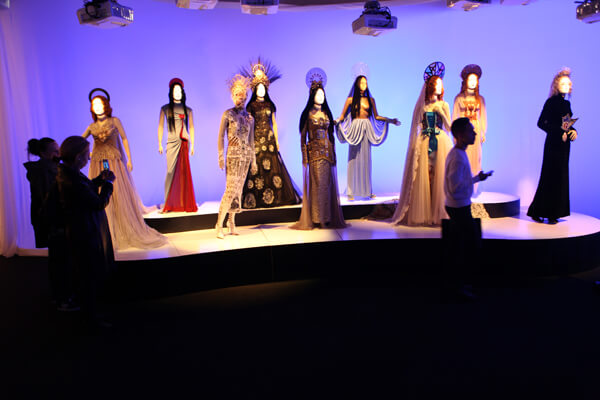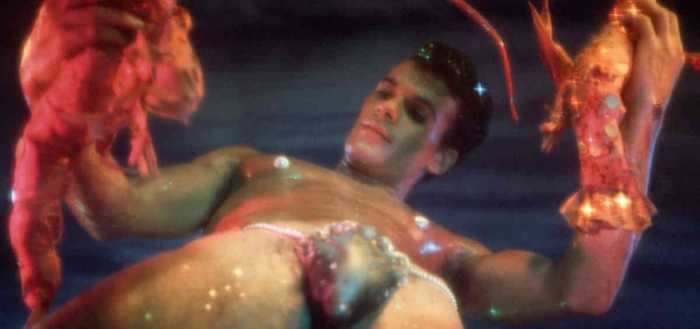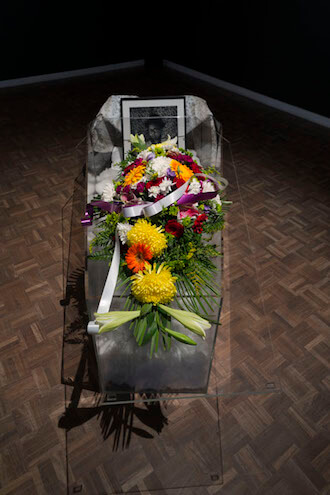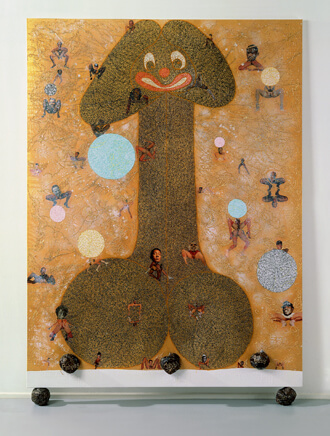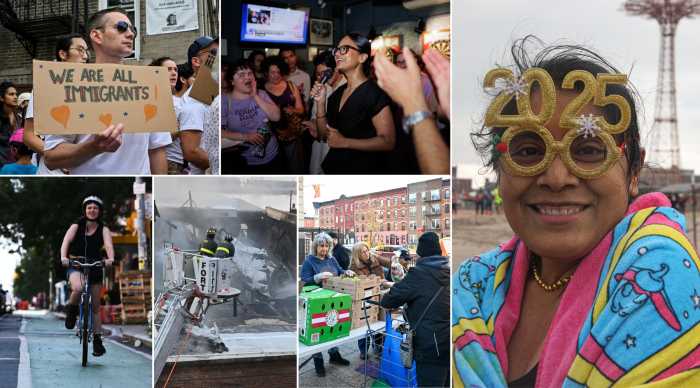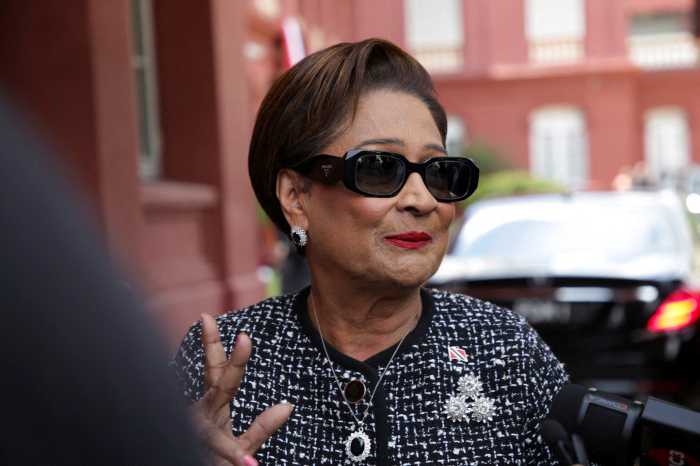Jean Paul Gaultier and Amanda Lepore. | ERIC WEISS/ BROOKLYN MUSEUM
My first trip to Paris was in 1981 and, as if in a fever dream, I wandered those redolent-of-everything streets, soaking up all that beauty and art and having the time of my life, as the exchange rate was then seven francs to the dollar. I stumbled into a hip boutique whose name infuriatingly eludes me now and was struck by the particular inventiveness of the clothes I saw there, which possessed a raffish, iconoclastic wit I’d never seen before, not even in that era’s explosive creativity of game-changing ready-to-wear designs from Kenzo, Issey Miyake, Claude Montana, France Andrevie, and Chantal Thomass. I was particularly taken with bracelets that were really nothing more than humble tin cans, polished to a rainbow-hued shine, that had the ebullient irreverence and tossed-away high-low chic I hitherto had associated only with Schiaparelli.
The designer’s name was Jean Paul Gaultier, one man who has never stopped creating the kind of astonishment the impresario Diaghilev once imperiously requested of Jean Cocteau. He is now the joyous subject of a major retrospective, “The Fashion World of Jean Paul Gaultier: From the Sidewalk to the Catwalk,” at the Brooklyn Museum. To call the show — which originated at the Montreal Museum of Fine Arts and is blessed now with fabulous additions for its New York stop — a blockbuster like the now-legendary Alexander McQueen exhibit at the Met, is not only an understatement but something of a misnomer. Walking through it, I could not help but be reminded of the McQueen exhibit, which had every daunting element of blockbuster about it, from its doubtlessly costly presentation to the hordes of people it attracted. McQueen — his career cut tragically short by suicide — shared with Gaultier a seemingly limitless creative vision and technical know-how. Yet his designs, as magnificent as they were, always possessed a somewhat dark and icy quality of edgy intimidation — a reflection of the designer’s conflicted, often insecure persona, but also spot-on, zeitgeist-wise. McQueen’s output was irresistible to the fashionistas who lived for it.
McQueen’s Met show was rife with the jaw-dropping “stand back, wonder, and admire” quality of its tortured genius, while the Brooklyn Gaultier, like the designer himself and everything he creates, is contrastingly filled with a positive, life-affirming joy that reaches out to warmly embrace his every admirer. You walk through this dazzlingly conceived couture pageant simply agog, and the awe grows — with each room magically unveiling ever more visually dazzling, technically masterful, truly inspirational sartorial richness.
Brooklyn Museum makes compelling case for this most creatively enduring of living designers
Most of Gaultier’s famous collections over the last three decades are vividly represented — his impenetrably luxe Tibet look, his African-American/ Black Girls, the Amy Winehouse tribute, his highly controversial Hasid defile, and my personal favorite, his flamboyant Frida Kahlo homage, when he sent out his models bearing the artist’s signature unibrow.
Farida Khelfa and Thierry Maxime-Loriet. | ERIC WEISS/ BROOKLYN MUSEUM
Emblematic of this show, brilliantly curated by Thierry Maxime-Loriot — present at the show’s press preview in an excruciatingly covetable JPG black leather jumpsuit — is an incredible assemblage of Jolicoeur International mannequins, which, instead of being traditionally cold, mute clothes hangers, have differing personalities, are expressively animated, and actually talk. I won’t spoil the surprise by describing how this is done — you’ll figure it out — but that will in no way lessen your admiration of this sublime innovation.
Extending this vital human touch, so rare in fashion, at the preview and formal opening event later that evening, Gaultier himself was wonderfully accessible — not ivory-towering himself away in a VIP section, but, despite publicists constantly yanking at him to spirit him away, stopping to happily answer questions and pose for selfies by all and sundry.
“I am thrilled that this show is in Brooklyn!” he said in his disarming, rat-a-tat Pepé Le Pew accent, which I won’t duplicate here. “I first came to New York 35 years ago and I remembered being so impressed by the Manhattan store windows, so beautifully displayed and much better than in Paris. And now I hear that Brooklyn is very hip, and even though I am older now, it is very nice to still be hip!” His own wonder and enthusiasm about his exhibit was divinely palpable, with none of the jaded or impenetrable quality — or even worse, fake humility — most fashionistas haughtily exude at such occasions.
The electric opening night party brought out New York’s fashion pack in duly obeisant droves, ranging from “Project Runway” tyro Christian Siriano to that craggy couture eminence Calvin Klein. (Watching him and Gaultier meet was like a literal collision between Creativity and Commerce.) Running into the singer Beth Ditto, whom Gaultier adores for the proud security with which she flaunts her own unfashionably zaftig form, the designer — who’s always embraced variegated body types — stopped and gave her, and everyone present, an impassioned, impromptu lecture about the 1944 film “Falbalas” before a wall projection of clips from it. Directed by Jacques Becker, with a sumptuous Marcel Rochas wardrobe and set in the milieu of a Parisian couturier, the film inspired Gaultier to become a designer. It starred the exquisite clotheshorse Micheline Presle, and, later, her daughter, filmmaker Tonie Marshall, made a documentary, “The Falbalas of Jean Paul Gaultier,” about his obsession.
Ditto, incredibly sweet and down-to-earth, led me to the two gorgeous gowns Gaultier created for her to perform in and also introduced me to her Asian girlfriend. Indeed, total lesbian chic held sway that evening, for I also ran into former supermodel Eve Salvail, one of the human models for those wondrous mannequins whose near-bald runway appearances in the 1990s were revolutionary. I asked her if Gaultier or any other designer had ever tried to change her look or ultra-butch commando catwalk stride. “Never,” she replied. “These designers hired me for exactly what I am.” Retired from modeling, she’s now very happy being a sought-after deejay. Salvail also proudly introduced me to her lady love.
“The Fashion World of Jean Paul Gaultier” run through February 23 at the Brooklyn Museum. | ERIC WEISS/ BROOKLYN MUSEUM
Gaultier’s love for models of differing physical types and age ranges has been a recurring theme of his career, and the exhibit is like a memory album of the miraculously different muses who have inspired him. “When I was in school,” he recalled, “there was this girl, very thin and pale. You could almost see the veins through her skin and she had this incredible, big red hair. She was everything that was not considered beautiful, but I thought she was beautiful.”
Parrot-faced Almodóvar actress Rossy de Palma, tattooed Japanese dyke model Jenny Shimizu, ultra-voluptuous Farida Khelfa, and androgynous Edwige are just some of his muses on display, but a stand-out is Tanel Bedrossiantz, the male model who, from 1985, used to drive me mad with envy whenever I’d see him defiantly strutting the catwalk, wearing, say, a tulle bustle. He is quoted in the show: “I realized hastily my differences with the male models of the moment. At that time models were very ‘Marlboro COWBOYS,’ fine gules, beautiful bodies, beautiful white teeth. I had just turned 18 years old, I had a big mouth, big ears, the silhouette of a disjointed puppet, was very different at that time. I had many Vogues at home, devouring the images with all the great female models and those inspired me a lot. I told myself that I was like more the body of girls than boys of the period, so I concluded it was necessary that I pose as a woman and also for the fashion shows.”
Although not overtly stated in the exhibit, a queer aesthetic has always been prominently evident in Gaultier’s oeuvre. I possess a pair of his white jeans, printed all over with what appears to be an inky black floral motif but which, on closer inspection, is actually a repetitive depiction of men having graphic sex. (I curse myself to this day for not having the nerve to buy the matching jacket.) His runway shows for his men’s collections were indeed outrageous, with models — from muscle hunks to ephebes like Tanel — flaunting full makeup, skirts, corseterie, gemstones, and boas, but they were never outrageous for mere outrageousness’ effect. All of it was not only very beautiful, but very wearable.
The first Gaultier I could ever afford to buy, at drastic markdown at the Soho boutique If, was one of his signature sailor-striped tops, in knit, with no back to it. I was thrilled to see it in the show, along with numerous other examples of this marine theme that, more than anything, has become his signature, even appearing on the bottle of his perfume, a quiet homage to Schiap, who used Mae West’s figure for her famous “Shocking” scent — only Gaultier used a male torso. Other recurring motifs, which attest to the consistency of his overall vision and make his clothes not only timeless, but a natural, easy fit together, whatever the year or season of their creation, include his innovative, masterful deconstruction, especially in the tailored pieces with which he made such a mark. And then, of course, there’s the lingerie worn as outerwear, which exploded onto the world on the back of a singer named Madonna.
Fans will thrill to see the Material now-Woman’s original costumes from various tours, as well as Polaroids from their first fittings (yes, the show is that comprehensive). You will also see garments you may have gasped at on TV or in magazines that have graced other divas — including Beyoncé, Marion Cotillard, Sarah Jessica Parker, and Catherine Deneuve — all documented according to the number of hours it took to create such walking works of art.
Above all, it should be remembered that Gaultier’s very first muse was — as with so many gay little boys — his own grandmother, the original source of all those girdles and corsets that fascinated him. “When I was little, I thought my grandmother was supremely elegant,” he recalls. “She was undoubtedly very old-fashioned but I considered her style absolutely wonderful. She had black crepe hats, feather aigrettes, and corsets from the early 1900s. She told me that women would drink vinegar to bring on stomach contractions and then pull the corset laces at precisely that moment to get a smaller waist. That was all food for my imagination.”
Along with adorable snapshots of Gaultier as a child, the show also includes this reminiscence: “[On television], I saw a show about the ‘Folies Bergère’ revue. The next day at my elementary school I drew a showgirl decked out in fishnet stockings and ostrich plumes. The teacher, who was usually very nice to me, made me get up on the dais at the front of the class, rapped me on the knuckles with a ruler, pinned the drawing on my back, and had me walk around all the other classrooms. It should have been a traumatic experience but it inspired my career. Suddenly my classmates saw me differently — they thought I was a laugh. The drawing made me part of the group. I was no longer the sissy who didn’t play soccer. For their part, my parents gave me their support and my grandmother read my tarot cards, which predicted I’d have a great future.”
THE FASHION WORLD OF JEAN PAUL GAULTIER: FROM THE SIDEWALK TO THE CATWALK | Brooklyn Museum, 200 Eastern Parkway, near Grand Army Plaza | Through Feb. 23: Wed., Fri.-Sun., 11 a.m.-6 p.m.; Thu., 11 a.m.-10 p.m.: First Sat. each month, 11 a.m.-11 p.m. : $12; $8 for students & seniors at brooklynmuseum.org

